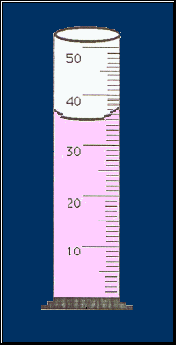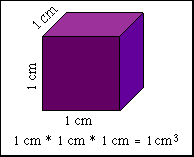

|
|
|
|
|
|
|
|
|
|
|
|
|
|
|
|
|
|
|
|
|
|
|
|
|
|
|
|
|
|
|
|
|
|
|
|
How do I measure the volume of a liquid?
Finding the volume of a liquid is easy, for all you need to do is pour
the liquid into a graduated cylinder and that's it's volume.
The reading below is at 35 ml. The cylinder is graduated
into mililiters. When a liquid is put into a cylinder, it does something
unusual. It curves. This curve is caused by a quality that liquids called
surface tension. When you read the graduated cylinder, you read it atthe
bottom of the curve. This is called the meniscus. 
 How
can I find the volume of a cuboid (a regular solid object)? To find
the volume of a regular solid object you measure length then width then
height. A regular solid is an object with measurable sides such as a cube.
An irregular solid is a solid without measurable sides such as a rock.
How
can I find the volume of a cuboid (a regular solid object)? To find
the volume of a regular solid object you measure length then width then
height. A regular solid is an object with measurable sides such as a cube.
An irregular solid is a solid without measurable sides such as a rock.
What about the volume of an irregular solid?
To find the volume of an irregular object you need more than just one tool. You need a graduated cylinder, an overflow can, and some water.
 Fill the overflow can with water to the brim and let all
the excess water drip out (the water above the nozzle.) Now place the cylinder
under the overflow can's nozzle and slowly drop the object into the water.
Now read the on the cylinder the amount of water that dripped out of the
overflow can and that is equal to the object's volume because 1 cc =1 ml.
Ml is the unit one uses for expressing the volume of a liquid. Cc or cm3
is the unit for expressing the volume of solids.
Fill the overflow can with water to the brim and let all
the excess water drip out (the water above the nozzle.) Now place the cylinder
under the overflow can's nozzle and slowly drop the object into the water.
Now read the on the cylinder the amount of water that dripped out of the
overflow can and that is equal to the object's volume because 1 cc =1 ml.
Ml is the unit one uses for expressing the volume of a liquid. Cc or cm3
is the unit for expressing the volume of solids.
How do I measure the volume of a prism?
In geometry, there are shapes called prisms. (See below.)
If you look closely you can see they are really one design piled on top of another. To find the volume of one of these shapes, first find how thick or high it is. Then, once you know that number, try to figure out the volume of one layer and then multiply it by that number. So, for instance, say you have a prism that is three inches thick. Then I have found that volume of one layer is 27 ccs. Next I would multiply 27 by 3 (For all who care, the answer is 81.), getting the volume.
There are many different kinds of prisms. There are prisms which have cubic centimeters taken out of the side, prisms which have cubic centimeters taken out of center, and lots of other different arrangements. To find the volume of a prism like the one below, follow these directions:
1. Find the volume of the shape, as if there was nothing taken out of the center.
2. Find out the volume of the space in the center.
3. Subtract the volume of the space in the center from the volume of the whole cube.
Does volume ever change?
To be plain and simple, yes. When matter changes from
one state to another, like liquid to gas, the molecules expand. For instance,
when if you heat butter and melt it so it changes from a solid to a liquid,
the butter naturally expands; and when you cool down the butter, it naturally
contracts. The expansion and contraction also happens going from the liquid
state to the gas state.